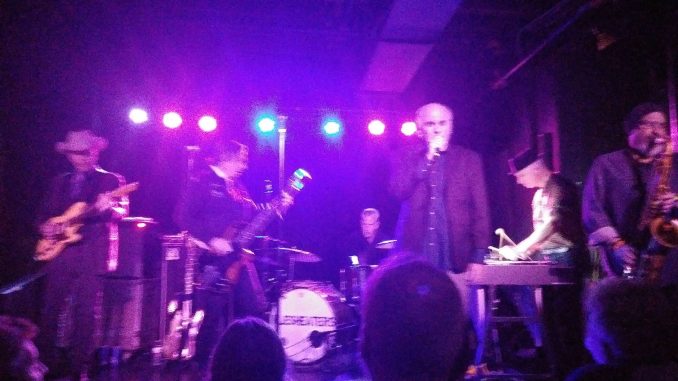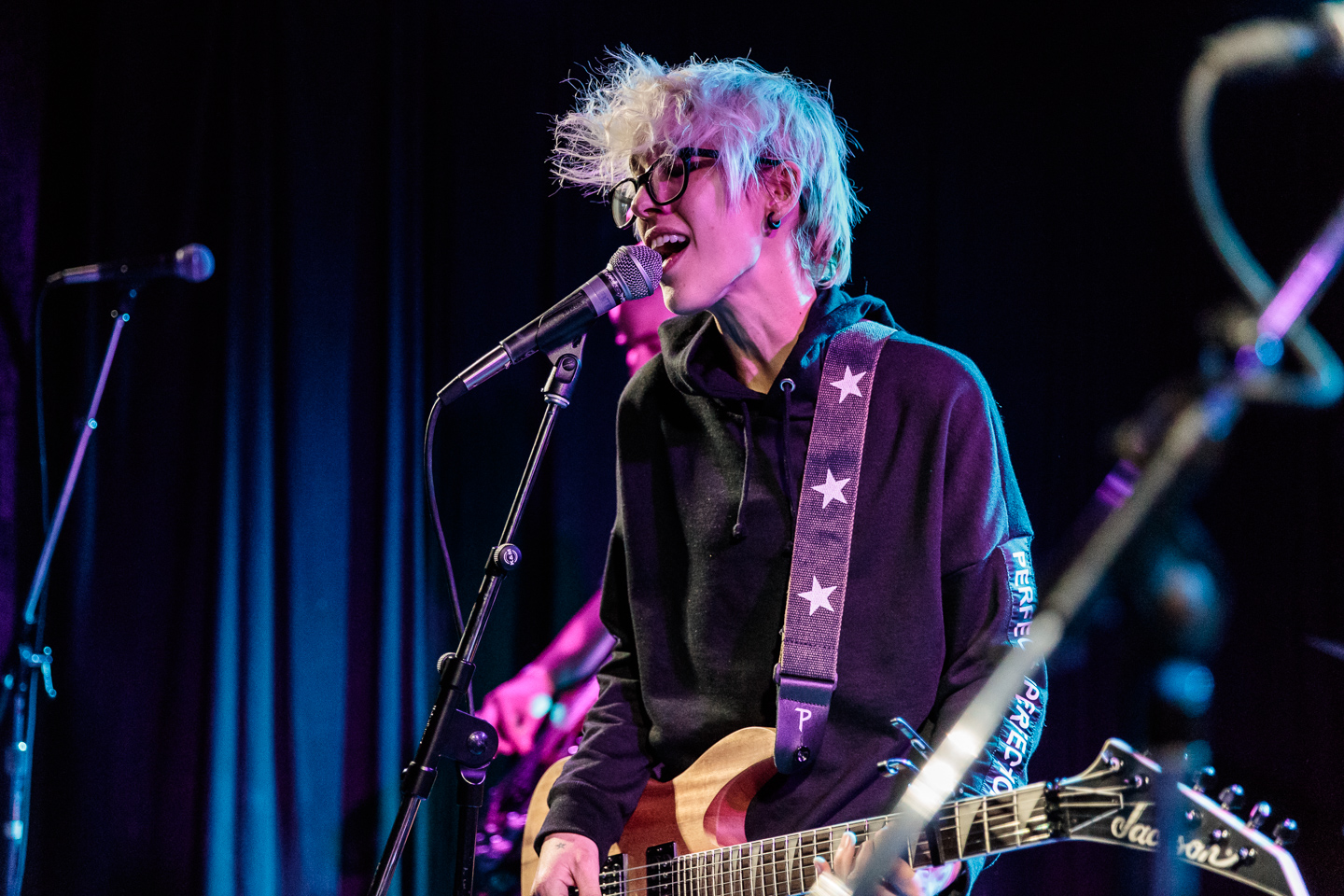
One of the great pleasures (and biggest challenges) of reviewing shows for TCM is the assignment to create a Top 5 Concert year end list. Note to self: There’s one. If Saturday night’s show isn’t at the top of that list, it’s been one hell of a year for music. That gig shook the rust off my old jaded ears and reminded me again why live music is the most powerful art form in the world.
There are a lot of great bands out there. There are artists who helped set the sound track to your life. We all love it when one of our rock and roll heroes cranks out and delivers that special anthem. But that’s not enough. Sometimes it’s those intangibles which elevate a concert to epic. The venue, the size and vibe of the audience, the people you are with or what it took to get there.
Porcupine and the legendary Flesh Eaters had it all in spades. Black, black spades. A night I’ll remember.
Saturday provided something like our 19th straight blizzard since the witch named February showed up. The roads on the way into The Turf’s friendly confines were quickly becoming impassable. So we inventoried who had the best snow tires. Then friends and family piled on in, with a promise to push as necessary. My wife Lisa kept questioning whether we were all going to die. We ignored her and promised a big glass of wine immediately upon arrival.
Big relief, arrival in one piece. A fortuitous decision to stay out of the un-plowed back lot. That was going to turn into jail in a couple of hours. Hunt down out a place to park, given a snow emergency cutting limited options in half. Then some quiet time down in the Clown Lounge for a burger and conversation with friends. Intangible one.
As the first notes from Porcupine’s Greg Norton’s bass came thundering down the stairs, we headed up to a nicely filled club. Intangible number two. Check. Not too big. Not too small. These were hardcore fans that would have fought a tornado to get there. Intangible number 3. But the storm may have knocked off 10% from the sold out size. Just enough room to move. Just the way I like it. Make it 4.
In the past year, I don’t think I’ve seen any band more often than Porcupine. Yes, they’re working in support of a great new album What You’ve Heard Isn’t Real; they’ve been busy. However, they’ve been paired with a whole bunch of bands that are right in my wheelhouse. So we keep crossing paths. Before the month is out, I’ll see them again as they open for Bob Mould.
Maybe it was the vibe. Maybe it was them. But this was my favorite Porcupine show to date. With a band like the Flesh Eaters coming up behind them, that’s saying a lot. Frankly, I try hard to appreciate the opener, yet keep glancing at my watch. It’s impossible to do that with Greg Norton on stage. No disrespect to front man Casey Virock or drummer Ian Prince. The former writes great songs and is a creative and noisy guitarist. The latter is an animated powerhouse behind the kit. But Norton is in a special class. It’s as though the power chord in the wall runs directly into his body rather than the amp. Does he play the music or does the music play him? Hard to tell: but it is the epitome of rock and roll abandon. Nobody is having more fun than he is. It’s infectious.
The crowd’s anticipation for seeing The Flesh Eaters was palpable. That was really strange because I’m willing to bet that over 90% had never seen the band. Most of us were unfamiliar with their limited catalog of music. Reputations was what had the place packed. It was a legend shrouded in mystery.
I began to think of The Flesh Eaters as the Traveling Wilburys of Punk. For a brief period in the early 80’s, as punk music began to grow up and find an original voice, a handful of LA’s greatest players briefly came together and made some serious music. It could not have happened anywhere other than SoCal. Just as The E Street Band had to come from Jersey, Gary Clarke, Jr from Austin. This was 1980 LA through and through.
I suspect X’s John Doe may well have been the nexus. DJ Bonebrake on vibes was part of that band. Americana master Dave Alvin brought along his Strat. Los Lobos’ sax player Steve Berlin showed up. The Blasters’ Bill Bateman parked behind the kit (I’ve written previously that in my humble opinion Bateman and bassist John Bazz comprise the most powerful rhythm section in the land).
Who needed a singer? Both Alvin and Doe are tremendous singers. But it’s punk and they set out to be like nobody else. So don’t go find a singer. Go find a radical punk poet in Chris D. Let him shout and whine and moan. Like a second generation Jack Kerouac shipped west from Greenwich Village.
Everybody knew whatever was going to happen would be over the top the instant the sound board cued the walk out music. Like some twisted gunslinger showdown scene from a Sergio Leone Spaghetti Western. The road manager discreetly signaled from the side of the stage. Turn. It. Up!….No. More. Thumbs up. If you were in The Turf Club, you were going to have to lean into the wind.
I don’t know how to describe what I witnessed beyond the fact that the band was utterly original. Every single one of the 14 main set songs and both encore numbers were freight trains. Complicated, yet accessible. Dark and powerful without an attitude that the music should tear down the pillars of society. Rock and roll dangerous while remaining good, clean fun. If sweaty can still be construed as clean.
Some music and bands don’t age too well. It’s hard to buy the image of a 60 something punk or rock icon. The songs are the same but it’s by rote, not hormones. It only works when there is something absolutely authentic and the music is fresh and challenging to the musicians. It doesn’t get more real than this.
In most great bands there is a focal point. Too much, or too many musicians competing for attention, muddies the water. That’s why the concept of super group very, very rarely ever works in practice. How many lead dogs can you effectively put in a string? I mean who is leading the band? In this case, it works. Every one of those players is a virtuoso in his own right. Yet the respect and enjoyment of doing something outside the normal nine dots was on the face of every one of them.
Dave Alvin is a monster. Pure and simple. One of my all time favorites; renowned for his Americana, bluesy style. Applied to scorching punk melodies? You better believe it. He brought the house down at some point in nearly every song. Noisy and aggressive, with the occasional Tex Mex flavor thrown in for good measure.
John Doe is mesmerizing. His bass playing effortless. He simply flows. At one point, my wife asked why everyone in the band had his eyes closed or were staring off into space. Plugged into some kind of music in the spheres. When and if a more melodic vocal layer was required to soften Chris D’s ranting, Doe stepped to the mic and provided it.
Bateman is like the Terminator. He’s one of those drummers who is not only sophisticated, he hits it like a ton of bricks. He never, never stops. I think the orchestration in the band was primarily Alvin. But you saw the silent cues and communication going on between those two. A bit of that shared Blasters history.
Who would have thought of using percussive vibes in a punk band? Well, I guess you can’t have a piano in a group of that ilk, can you? Pianos are for sophisticated folk. The vibes are more aggressive. More in your face. Part of punk is about stripping away most of the superfluous and getting to the core.
A sax is so old school. Again something you simply don’t expect in a band of this type (but again the question…has there ever been another band of this type?). In the early days of rock and roll, it was a saxophone out front. Then Buddy Holly hit the scene and the world changed. In this band, it was a perfect complement to Alvin’s searing guitar. Fattening up that sound and often creating just enough tension to keep you off balance. All night long the band walked this incredibly fine line between noisy chaos and music that drew you in.
The only thing predictable about The Flesh Eaters’ music was a basic formula which simply said: Start with a groove. Get it fully established. And then when it darts off in some direction, everybody keep up. Ride that thing until it explodes out the back end.
So where do these guys fit in the continuum? After all, everything comes from some kind of influence, doesn’t it? It’s more about the echoes and the mixing, the alchemy, that defines originality. My best guess is that somewhere in the back of their 1980 minds was the music of Captain Beefheart. Go there. But hang on to just a bit more accessibility. Then think of Nick Cave and The Bad Seeds and ask yourself if he didn’t have that early Flesh Eaters album.
Slogging 25 miles home, on roads not yet cleared, remains a blur. I was awake for hours, so inspired by the show. I knew exactly one song in the set. Life To Live showed up as the sixth song of the set. My notes and the crowd reaction say this was the most exciting song I’d heard from a stage in years. And then they built on it. Amazing!
It’s alchemy pure and simple. Take base metals, mix in the proper proportions and distill pure gold. You toil night after night watching bands and writing about them. Then one night, in the middle of Snowmageddon, you look up and it glitters.



